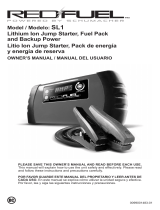
• 16 •
3. Ponga los cables de CD lejos de las aspas del ventilador, bandas, poleas
u otras partes móviles. Asegúrese de que todos los aparatos eléctricos
del vehículo estén apagados.
4. En un vehículo con descarga a tierra por borne negativo, conecte el
gancho POSITIVO (ROJO) desde el arrancador al borne POSITIVO
(POS, P, +) sin descarga a tierra de la batería. Conecte el gancho
NEGATIVO (NEGRO) al chasis del vehículo o al bloque motor
alejado de la batería. No conecte el gancho al carburador, líneas de
combustible o cuerpos metálicos. Conecte a una pieza metálica de
calibre grueso del marco o del bloque motor.
5. En un vehículo con descarga a tierra por borne positivo, conecte el
gancho NEGATIVO (NEGRO) desde el al borne NEGATIVO (NEG, N, -)
sin descarga a tierra de la batería. Conecte el gancho POSITIVO (ROJO)
al chasis del vehículo o al bloque motor alejado de la batería. No conecte
al carburador, líneas de combustible o cuerpos metálicos. Conecte a una
pieza metálica de calibre grueso del marco o del bloque motor.
6. Deslice el interruptor ON / OFF a la posición ON. El LED verde del cable
inteligente debe encenderse.
NOTA: Si la batería del vehículo está muy descargada, el consumo
de corriente inicial del arrancador puede activar la protección de
cortocircuito en el cable inteligente. Cuando se corrige la condición, el
cable inteligente se reajustará automáticamente.
7. Después de una conexión adecuada se ha hecho, haga girar el motor.
Si el motor no arranca dentro de 5-8 segundos, deje de arranque y
espere al menos 1 minuto antes de intentar arrancar el vehículo nuevo.
NOTA:
Si el coche no arranca por segunda vez, compruebe el cable
inteligente para ver si el LED verde está encendido. Si oye un pitido o/y el
LED parpadea, consulte la sección 10, Resolución de Problemas.
Cuando
se corrige la condición, el cable inteligente se reajustará automáticamente.
NOTA: El clima frío puede afectar el rendimiento de la batería de litio del
arrancador. Si escucha a un clic y el motor no gira, pruebe lo siguiente:
Con el motor de arrancador conectado a la batería del coche y el
LED verde iluminado en el cable inteligente, encienda todas las luces
y accesorios eléctricos durante un minuto. Esto llama la corriente
desde el arrancador y se calienta la batería. Ahora trata de poner en
marcha el motor. Si no se enciende otra vez, repita el procedimiento.
Extremadamente frío puede requerir dos o tres calentamientos de la
batería antes de que arranque el motor.
NOTA: Si no se detecta actividad, el cable inteligente se apagará
automáticamente después de 120 segundos, y los LED rojo y verde
estarán solidos. Para reiniciar, desconecte las pinzas de la batería del
vehículo y luego vuelva a conectar.
IMPORTANTE:
NO intente poner en marcha su vehículo más de tres
veces consecutivas. Si el vehículo no arranca después de tres intentos,
consulte a un técnico de servicio.
8. Después de arrancar el motor, desenchufe las pinzas de la batería
desde el arrancador y luego desconecte la pinza negro (-) y la pinza roja
(+), en ese orden. Deslice el interruptor ON / OFF a la posición OFF.
9. Cargue la unidad tan pronto sea posible, después de usarse.























